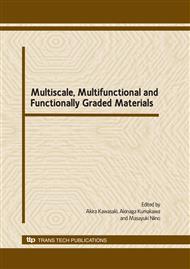[1]
A. Kawasaki and R. Watanabe: Ceramics International, Vol. 23 (1997), p.73.
Google Scholar
[2]
M. M. Gasik: Materials Science Forum Vol. 423-425(2003), p.17.
Google Scholar
[3]
S. Uemura: Materials Science Forum Vol. 423-425(2003), p.1.
Google Scholar
[4]
A. Kawasaki and R. Watanabe: Nippon Kinzoku Gakkai-si Vol. 51 (1987), p.525.
Google Scholar
[5]
Functionally Graded Materials Database on http: /www. fgms. net.
Google Scholar
[6]
G. Kaneko, M. Mori, H. Kitagawa, K. Hasezaki, and H. Tanaka: Journal of the Japan Society of Powder and powder Metallurgy, Vol. 53 (2006), p.503.
Google Scholar
[7]
K. Hasezaki, A. Nakashita, G. Kaneko and H. Kakuda: Materials Transactions, Vol. 48 (2007) p.3066.
Google Scholar
[8]
K. Nakano and S. Nishida: American Society of Mechanical Engineers, Pressure Vessels and Piping Division (Publication) PVP Vol. 302(1995), p.283.
Google Scholar
[9]
K. Atarashiya: Journal of Materials Processing Technology Vol. 54(1995), p.54.
Google Scholar
[10]
C. Chu, Z. Yin, J. Zhu, S. Wang and P. Lin: Functional Graded Materials 2000, Ceramic Transaction, Vol. 112(2001), p.81.
Google Scholar
[11]
M. Yuki, Y. Nakanishi, A. Kawasaki and R. Watanabe: Keisyazairyou Symposium (FGM'93), (1993), p.47.
Google Scholar
[12]
H. Yamaoka, M. Yuki, K. Tahara, T. Irisawa and R. Watanabe: Keisyazairyou Symposium (FGM'91), (1991), p.73.
Google Scholar
[13]
L. M. Zhang, R. Yuan, M. Oomori and T. Hirai: Journal of Materials Science Letters Vol. 14(1995), p.1620.
Google Scholar
[14]
P. Hvizdos, D. Jonsson, M. Anglada, G. Anne and O. Van Der Biest: Journal of the European Ceramics Society Vol. 27(2007), p.1365.
Google Scholar
[15]
C. Kawai and S. Wakamatsu: Journal of Materials Science Vol. 31(1996), p.2165.
Google Scholar
[16]
M. Katoh, H. Hoita and T. Igarashi: Keisyakinouzairyou-ronnbuusyu (FGM'98), (1998), p.97 Acknowledgment We thank Sakae Mishima, Yoshiaki Suzuki, and Kazuki Kikui of the Industrial Research Institute of Tottori Prefecture for mechanical testing.
Google Scholar


